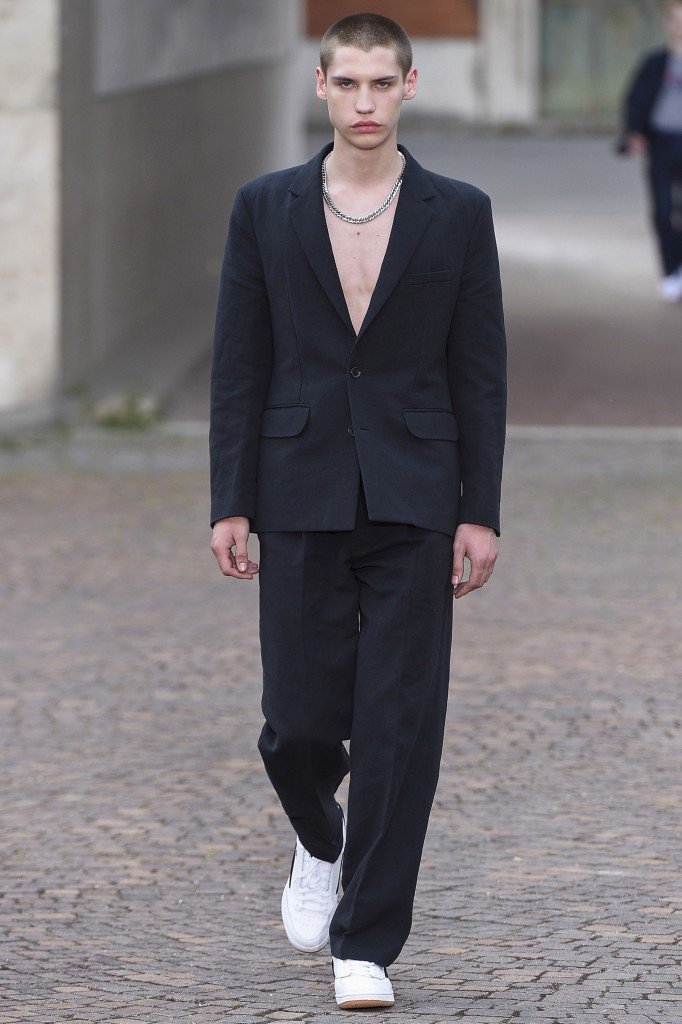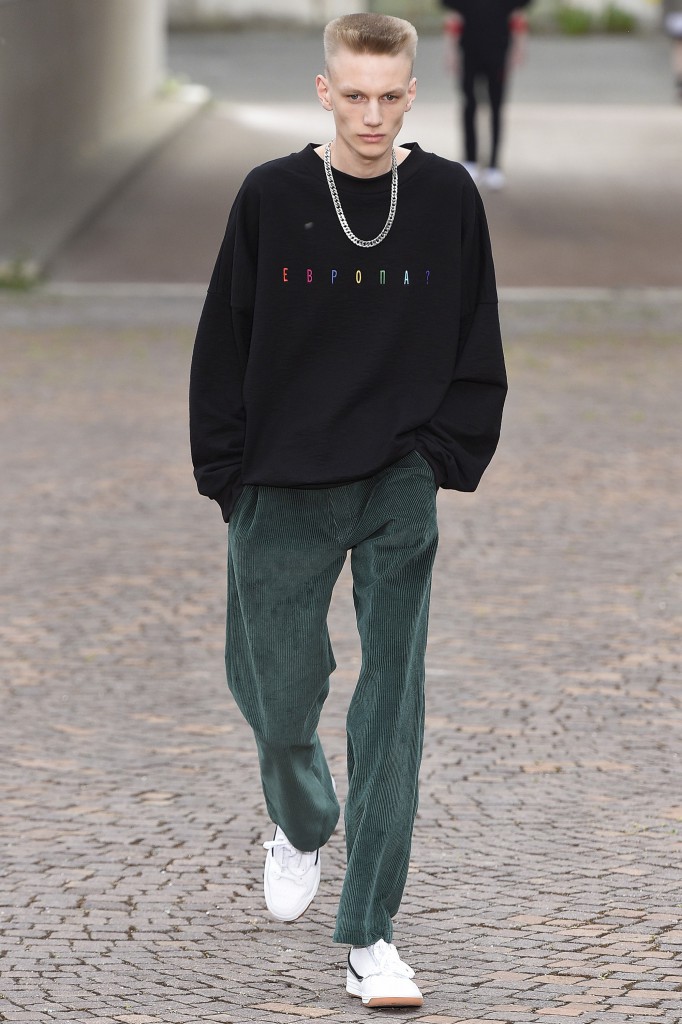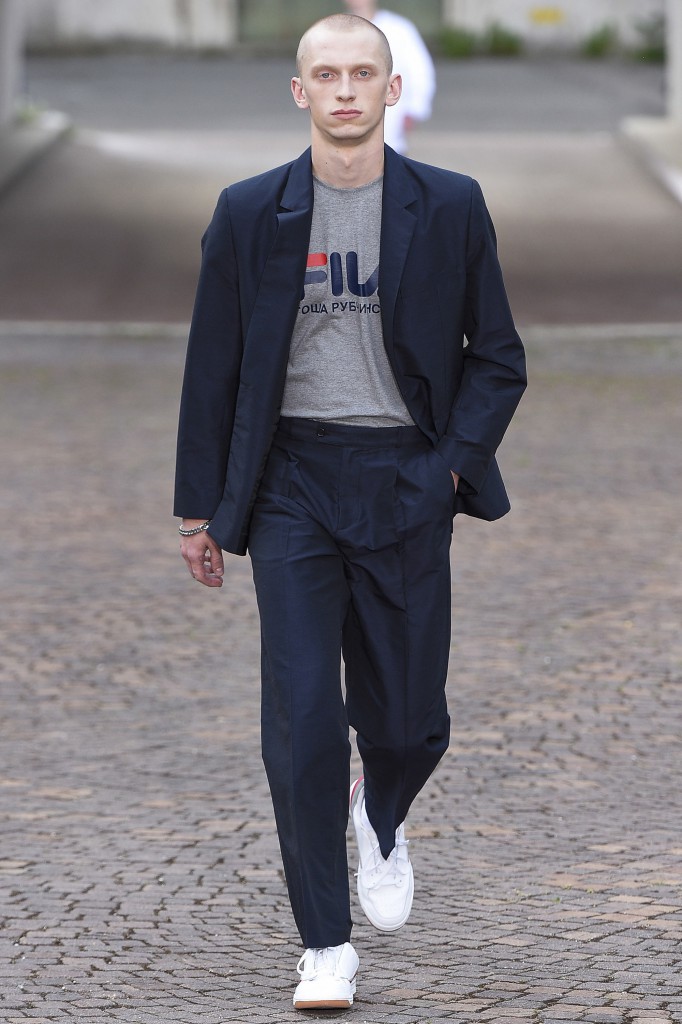Gosha Rubchinskiy Menswear Spring 2017, Florence
A change of scenery, a change of pace. The menswear designer invited by Pitti Immagine to stage a show in Florence for Spring 2017 is Gosha Rubchinskiy. Moscow born, based, and somewhat obsessed, his collections thus far have unraveled his Soviet identity, nostalgically harking back to the time before the curtain fell, and immediately after. He’s offered branded sportswear like ersatz ’80s Russian Olympic gear, and reclamations of teenage clubbing attire from the mid-’90s. What would Gosha do in Italy, though?
Firstly, he found “the only Soviet-looking building in Florence,” to borrow the words of his stylist Lotta Volkova—a tobacco factory in the high rationalist style, built in the ’30s and abandoned 15 years ago. Most of the building was derelict, the show staged in a courtyard bordered by stained concrete and smashed windows. It also provided the backdrop for a short film by Renata Litvinova—Rubchinskiy and Volkova also featured. The film was dedicated “To Pier Paolo.”
Pasolini was the key inspiration for Rubchinskiy—the life and death of the man himself, as well as his creative output. He was a communist, for one, which no doubt appealed to Rubchinskiy’s Eastern Bloc fascinations (then again, so was Miuccia Prada). The sly undercurrent of sexuality that is so often evident in Rubchinskiy shows was here more explicit: The first model, bare-chested beneath a loose-cut pinstripe suit, could stand in for Pasolini’s teenage lover Ninetto Davoli, or Pino Pelosi, the 17-year-old hustler who confessed to his murder in 1975.
If Rubchinskiy has referenced generations of Soviet youths in seasons past, these Italian ragazzi felt tied intrinsically to the reality of modern streets Rubchinskiy has contributed heavily to—namely, the streetwear-clad legions of contemporary menswear. The designer showcased multiple collaborations with a veritable closet of historically Italian sportswear labels—Fila, Kappa, and Sergio Tacchini. Each iteration, combining classic elements of the brand with Rubchinskiy’s own signature branding, had the feel of black-market counterfeits. Indeed, it was only after the show (upon inspecting labels, and asking the right people the right questions) that you could ascertain if those Canal Street–style sweatshirts with Fila’s serpentine logo and Gosha’s name stitched below in trademark Cyrillic were real or make-believe. Most plumped for the latter camp. More fool them. There was also a hookup with Levi’s to create Gosha-brand denims and corduroy jackets.
More than any of Rubchinskiy’s other collections, this linked to the idea of a wardrobe: sportswear-focused, sure, but aren’t many people’s entire lives geared up to athletic gear? The standouts in Rubchinskiy’s Italian debut were, surprisingly, the tailored pieces, rounding out his guy’s closet, offering his loyal customers something new, and maybe even securing fresh blood. The opening pinstripe, a pair of double-breasted velvet jackets, cut confidently broad of the body and wide in the shoulder, even had a touch of another leading designer to their swaggering shapes. Giorgio Armani. That’s something you never expected of Gosha. It was certainly something he’d never shown before.
Last season, Rubchinskiy cited the end of a cycle, and the beginning of something new. Perhaps that means a move away from his usual stomping ground, both creatively and physically. The shift to Florence seems to have shifted his creativity. It kicked it up a gear.
Source: Vogue.com.
Text: Alexander Fury, Vogue.com.
All images belongs to the respective artist and management.


